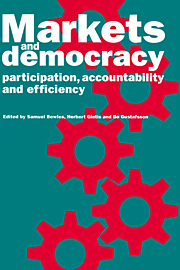Book contents
- Frontmatter
- Contents
- List of figures
- List of tables
- Preface
- 1 Post-Walrasian political economy
- Part I Agency, incentives, and democratic accountability
- Part II Institutions and institutional change
- Part III Conditions for the success of the democratic firm
- 8 After the employment relation: problems on the road to enterprise democracy
- 9 Unions versus cooperatives
- 10 Demand variability and work organization
- 11 Democracy versus appropriability: can labor-managed firms flourish in a capitalist world?
- Part IV Productivity, distribution, and power
- Part V Ownership, participation and capital markets
- Part VI Political democracy and economic democracy
- Bibliography
- Author index
- Subject index
10 - Demand variability and work organization
Published online by Cambridge University Press: 05 March 2012
- Frontmatter
- Contents
- List of figures
- List of tables
- Preface
- 1 Post-Walrasian political economy
- Part I Agency, incentives, and democratic accountability
- Part II Institutions and institutional change
- Part III Conditions for the success of the democratic firm
- 8 After the employment relation: problems on the road to enterprise democracy
- 9 Unions versus cooperatives
- 10 Demand variability and work organization
- 11 Democracy versus appropriability: can labor-managed firms flourish in a capitalist world?
- Part IV Productivity, distribution, and power
- Part V Ownership, participation and capital markets
- Part VI Political democracy and economic democracy
- Bibliography
- Author index
- Subject index
Summary
Introduction
While worker participation in decision-making has been a popular topic in the business press for much of the last decade, substantive participation by workers remains relatively rare in the USA (Levine and Strauss, 1989). Many economists have concluded that the low incidence of participatory arrangements in the USA implies that such arrangements are inefficient – for if participation were a good idea, then the market would favor companies with participation (Alchian and Demsetz, 1972a; Jensen and Meckling, 1979; Williamson, 1980).
The argument that “survival of the fittest” implies efficiency is not correct if there are externalities from work organization – that is, if one company's choice of work organization affects the costs of other firms. Several examples of such externalities are presented in Chapters 1, 11, and 6 in this volume (by Bowles and Gintis, Dow, and Pagano, respectively; see also my survey article with Tyson, 1990).
The current chapter focuses on a single externality of participatory work organizations, a macroeconomic externality that stems from the tendency of participatory workplaces to avoid layoffs when product demand declines. To see the basic argument, consider two fictitious auto plants X and Y. Plant Y has a highly trained work force and a participatory work organization with a no-layoff pledge. Its competitor in the auto industry is plant X, which utilizes a traditional US labor relations system. At both X and Y nominal wages are set once a year. Plant X lays off workers whenever there is a downturn in demand. Plant Y, on the other hand, avoids layoffs during downturns by retraining workers, freezing hire, transferring workers within the firm, and ultimately hoarding excess labor.
- Type
- Chapter
- Information
- Markets and DemocracyParticipation, Accountability and Efficiency, pp. 159 - 175Publisher: Cambridge University PressPrint publication year: 1993
- 4
- Cited by



